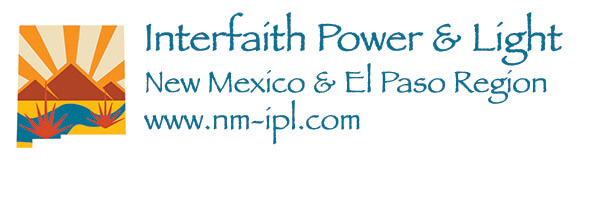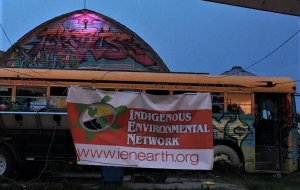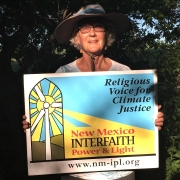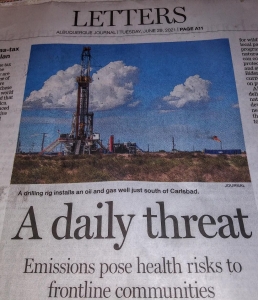Reflections from a New Mexican at the Line 3 Protests in Minnesota
I first became conscious of the White Earth and Red Lake Nations fight to stop construction of the Line 3 pipeline by Enbridge when I heard Tara Houska present at the BiPoc Climate Dialogue on April 8, 2021. Tara spoke eloquently about the treaty rights and the need to resist further degradation of Anishinaabe lands and waters.
When the indigenous women of northern Minnesota invited others to come join protesting the Line 3 replacement pipeline, my husband Ward and I decided it was the right thing to do to drive to the Treaty People Gathering held June 5-8 in Waubon, MN.
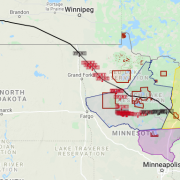 Line 3 is a tar sands pipeline currently under construction through northern Minnesota – violating treaty rights, risking over 200 bodies of water with the threat of an oil spill, and reversing our progress on climate change with a carbon equivalent of 50 coal-fired power plants.
Line 3 is a tar sands pipeline currently under construction through northern Minnesota – violating treaty rights, risking over 200 bodies of water with the threat of an oil spill, and reversing our progress on climate change with a carbon equivalent of 50 coal-fired power plants.
In preparation, we both participated in the mandatory orientation calls to attend the Gathering. Early on, we were uncertain what level of action and risk of arrest we were willing to take but went mentally prepared for possible arrest and took cash for bonding out.
Both of us knew we were called to stand with indigenous leaders and other Water Protectors in this fight for Mother Earth and all beings. We had support from both NM Interfaith Power and Light and 350NM, two climate action organizations in which we are very active.
Note: Climate advocates from NM-IPL, 350 New Mexico and other environmental organizations have organized protests outside of Wells Fargo Bank buildings in Albuquerque (200 Lomas Blvd NW) and Los Lunas (1027 Main St. SE) on Monday, July 19 at 11:00 a.m. Wells Fargo is one of the institutions that is financing the project. For more information, contact Ann McCartney, asims98891@aol.com
A Water Bowl from Santa Clara Pueblo
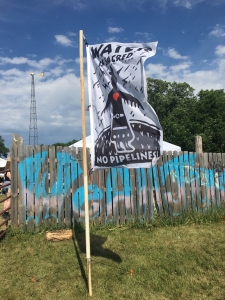 On June 3 with started out from Albuquerque with a beautiful small black bowl with an embossed water serpent made in Santa Clara and a vase of Rio Grande River water to take to the Indigenous women in honor and in thanks for the invitation to join them to fight the pipeline. Arriving at the remote “Pure Bliss Ranch” on Anishinaabe land on June 5, we were greeted by many volunteers to help us check in, find a camping spot, and carry our gear across a stream and into the gorgeous woods of Minnesota.
On June 3 with started out from Albuquerque with a beautiful small black bowl with an embossed water serpent made in Santa Clara and a vase of Rio Grande River water to take to the Indigenous women in honor and in thanks for the invitation to join them to fight the pipeline. Arriving at the remote “Pure Bliss Ranch” on Anishinaabe land on June 5, we were greeted by many volunteers to help us check in, find a camping spot, and carry our gear across a stream and into the gorgeous woods of Minnesota.
Two thousand people showed up for the Treaty People gathering and we sat under large pavilion tents in the hot sun for the welcoming talks, songs, and prayers. Dawn Goodwin, Everlasting Wind, was our unfailing guide and we heard stories from the ten year history of action against the pipelines from many indigenous leaders. We understood, as white people, we were there to listen and do what we could to protect and elevate the voices of the native people whose voices have so long been ignored.
The next morning was the day of action training and after inspirational talks, Ward and I chose to be in the red group – the group most willing to risk arrest, and attended the red group training. Two sites were identified for action and the red group prepared expecting police protection to be in place at the site upon our arrival.
We practiced how to maneuver around or through a line of police. Volunteers helped us write the jail support number on our bodies in case our belongings were taken from us upon arrest. Ward and I joined two other supporters to form an affinity or support group to act in concert together. Another requirement was for our affinity group to have a driver to drop our group at the action site so our car would not be parked at the highway during the action.
A Day of Action
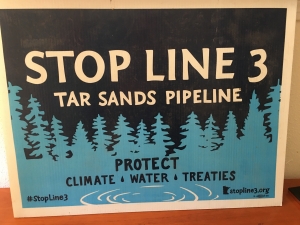 We were set and rose early on Monday, June 7 for the day of action. Two Inlets Pumping Station was our goal (which we were not told ahead of time) and after we passed other protestors at the access road, we walked into the pumping station. Enbridge had vacated the pumping station because of the protest and with the other protestors, we occupied the site. Winona La Duke, Tara Houska and Jane Fonda, and other notables, came and spoke to the protestors and the press about the reasons to stop Line 3. Collectively we occupied the site for several hours, both within the site and out at the access road protest line. During the morning, a Department of Homeland Security helicopter swooped down kicking up dust and issued an order to disperse.
We were set and rose early on Monday, June 7 for the day of action. Two Inlets Pumping Station was our goal (which we were not told ahead of time) and after we passed other protestors at the access road, we walked into the pumping station. Enbridge had vacated the pumping station because of the protest and with the other protestors, we occupied the site. Winona La Duke, Tara Houska and Jane Fonda, and other notables, came and spoke to the protestors and the press about the reasons to stop Line 3. Collectively we occupied the site for several hours, both within the site and out at the access road protest line. During the morning, a Department of Homeland Security helicopter swooped down kicking up dust and issued an order to disperse.
Around 4 p.m. in the afternoon, three busloads of police officers arrived from a side road. The red group gathered around the pump site to try and break or go around the line of police officers who immediately surrounded the site. The protestors who were still inside the work site were arrested – and the water protectors who had locked themselves to the machinery inside the site were unlocked and arrested.
Ward and I stood with the line facing the line of police officers, chanting to stop line 3 until 6 p.m. Some of the protestors turned the chants into anti-police rhetoric, which we did not support, as we had gone to stop a pipeline, not to confront the police for being police. The chants directed at them seemed contrary to our collective mission, and we chose to return to the Treaty People Gathering camp and not stay to be arrested. One hundred seventy-nine protesters who stayed at the protest line at the pump station were arrested or given citations for trespassing.
A Message to President Biden
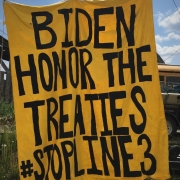 The message went to President Biden about why the Line 3 replacement line must be stopped as it violates treaty rights and promotes the use of dirty fossil fuels all over the world when our land, air and water are progressively deteriorating. It was an honor and a privilege to stand with our indigenous leaders and to promote and elevate their voices to the extent possible.
The message went to President Biden about why the Line 3 replacement line must be stopped as it violates treaty rights and promotes the use of dirty fossil fuels all over the world when our land, air and water are progressively deteriorating. It was an honor and a privilege to stand with our indigenous leaders and to promote and elevate their voices to the extent possible.
In many ways, our hearts are still with them, and we wish we could be there to continue the fight against fossil fuel use and the degradation of the sacred lands and waters of northern Minnesota. We are continuing the protest by having actions on July 19 at 11:00 a.m. at two Wells Fargo locations asking Wells Fargo and other banks to not renew their loans to Enbridge which fund the building of the Line 3 replacement pipeline.
(The author, a resident of Valencia County, is co-chair of the NM-IPL board. She is active with NM IPL’s Cool Congregations Committee and the Forest of Bliss tree planting project. She and her husband Wade McCartney attended the protest and gathering in northwestern Minnesota).
